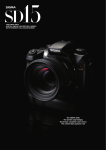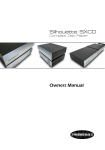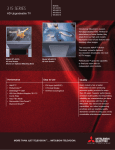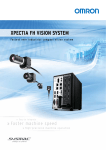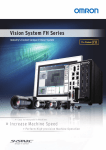Download Sigma PHOTO PRO 2.5 Specifications
Transcript
For photographers
who refuse to compromise.
The SIGMA SD1 Merrill
Inspired modern craftsmanship
Sensor designed in California
Camera made in Japan
The Sigma SD1 Merrill, The new benchmark for image quality and camera performance is now within your reach.
Our quest for photographic truth
and innovation resulted in the
SIGMA SD1.
Breathtaking gradation and rich
color fidelity. Image quality on a par
with medium-format film cameras.
A dream camera able to satisfy the
highest expectations of the world’s
most demanding photographers.
Only one thing remained to be
accomplished. That was to bring
this remarkable performance within
02
reach of more photographers who
wanted the very best. Since our
founding this has always been one
of our highest priorities with all of
our products.
First we pioneer new frontiers,
pursuing every possibility.
Then we do everything we can to
make the technology accessible.
After a year of hard work, we have
attained our mission.
Introducing the SIGMA SD1 Merrill
— the camera photographers
everywhere have been waiting for.
Transforming leading-edge
innovations into the world’s next
standards. Embodied in products
dedicated to everyone who is
fascinated by the potential of
photography.
The SIGMA SD1 Merrill.
A labor of love, born of a dedication
to photographic perfection without
compromise.
Camera : SIGMA SD1 Merrill / File Type: X3F Raw, Exposure Mode: P - Program AE, ISO Setting: 100, White Balance: Auto, Shutter Speed: 1/100s, Aperture Value: F2.8 Focal Length: 55 mm | Lens : SIGMA 24-70mm F2.8 IF EX DG HSM
03
04
Camera : SIGMA SD1 Merrill / File Type: X3F Raw, Exposure Mode: A - Aperture Priority AE, ISO Setting: 100, White Balance: Auto, Shutter Speed: 1/800s, Aperture Value: F7.1 Focal Length: 70 mm | Lens : SIGMA 24-70mm F2.8 IF EX DG HSM
Impeccable image quality. Cutting-edge technology.
Our flagship camera has it all
Preserving once-in-a-lifetime
moments
Photographs can preserve special
moments and breathtaking scenery
for eternity. They can also let us
express feelings and share ideas.
At Sigma we consider the capture
system to be the key factor in
photographic performance.
After all, photography is meant to
reflect truth, and cameras are tools
to take photographs. Pursuing the
goal of photographic perfection is
a matter of creating the ultimate
capture system.
Some may say that digital
imaging technology has already
reached maturity and that further
innovation will be insignificant.
We, however, beg to differ.
technology. This full color capture
system uses three layers of
photodiodes vertically aligned
to capture all three primary RGB
colors of light at each photosite.
We take this approach because we
believe in focusing on innovation
that can make a real difference in
the quality of photographs.
Pioneering the camera's future
with the SIGMA SD1
Ever since its inception,
the Foveon X3® direct image
sensor has earned a unique
reputation for its three-dimensional
ambience. The SIGMA SD1
marked another milestone in this
dimension of "emotional image
quality," producing photographs
mesmerizing in their lifelike
presence.
Delivering truly high image quality
When it comes to the capture
system at the heart of
photography, most digital cameras
are treading the same well-worn
path, using technology that has
hardly changed since digital
photography's infancy.
In contrast, Sigma is taking
a completely different tack,
developing direct-image sensor
technology to achieve true
progress in the key areas of
the capture system and image
generation.
Sigma is also the only camera
maker committed to perfecting
Foveon X3® direct image sensor
Its larger sensor size has triple
the pixel count of its predecessor.
With the increased resolution of
so many more pixels added to
the capture system's intrinsically
rich image quality, the result is
amazingly nuanced gradation
and color fidelity.
Such astonishing image quality
makes conventional digital cameras
pale by comparison. It also clearly
indicates the direction Sigma is
heading in pursuit of photographic
excellence and the ideal camera.
A flagship that puts Sigma's
principles into practice
It may look like a standard SLR,
but its images have the detail and
clarity you might expect from
a medium-format film camera.
Their vibrant, richly textured
realism awakens the desire to take
creative photographs.
The good news is that the SD1
Merrill has all the impeccable
imaging performance and buildquality of the SD1.
Achieving mass production of such
a camera that we could endorse
without reservation was no easy
task. But when you hold the SD1
Merrill in your hands you will
understand why it was worth it.
The sensor was designed in
Silicon Valley, the epicenter of
semiconductor innovation.
The camera is made entirely
in-house by Sigma in Japan.
This combination of cutting-edge
technology and a proud tradition
of precision artisanship has
produced a creative tool destined
to inspire the artistic soul of every
serious photographer.
The eye-opening impact of this
camera's image quality is the result
of an uncompromising devotion
to principles and a passion for
excellence.
Now it is our pleasure to be able
to make such quality available to
more photographers than ever
before. Our humble hope is that
using the SD1 Merrill will stimulate
your creative impulse in a way no
other camera can.
05
Astonishing 46MP resolution.
Breathtaking gradation and rich color fidelity
Do mega pixels matter?
end up looking unnatural.
Today's digital cameras have already
reached impressive pixel counts.
The figures seem sufficient to
generate high-resolution images,
and even to withstand scrutiny in
enlarged prints. A plausible case is
often made that the mega-pixel wars
are meaningless because digital
cameras already have enough pixels.
As an example, say you are
shooting a landscape with grass in
the foreground and mountains in
the background. The thin, closely
spaced blades of grass are resolved
correctly by the sensor in some
areas, but exceed the limit of
resolution in others. On the other
hand, the ridges and surfaces of
the mountains in the distance have
a low enough spatial frequency to
be resolved correctly throughout.
In other words, the foreground
would appear partially blurred
against a consistently sharp distant
background. A human observer
would register the opposite: sharply
defined blades of grass nearby, and
hazy mountains in the distance.
The claim gains further support from
an understanding that resolution
is not determined by pixel count
alone. In a photograph, resolution
also depends on interactions among
many other factors, including lens
characteristics, low-pass filter
response, noise reduction, and
processing of contrast and sharpness
parameters. By itself, elevating the
pixel count doesn't necessarily lead
to an appreciable improvement in
picture quality.
Consider the 14MP direct image
sensor used in the Sigma SD15
and Sigma DP1/DP2. Despite
having a nominal 4.6 million figure
for the number of pixel locations,
this sensor produces images that
are widely recognized as having
excellent resolution.
This limit of resolution, which can
be at odds with the human visual
system, may be an unavoidable
fact of physics. But Sigma believes
innovation can make the problem
so imperceptible that we can
realistically pursue and achieve
more natural image depiction. If so,
we can look forward to being able
to shoot images that are minimally
affected by enlargement, and that
retain a three-dimensional ambience
even when viewed in small formats.
triples the 14MP resolution of the
sensor used in previous generations
of Sigma cameras, while retaining
the "emotional image quality"
that is unique to a full-color
capture system.
We enlarged the sensor to APS-C
size (1.5x focal length equivalent),
while narrowing pixel pitch, thereby
dramatically raising the pixel count
to 46MP (4,800 x 3,200 x 3).
The luminance resolution of this
sensor is, in fact, equivalent to that
of a 30MP CFA sensor as measured
on the standard B&W resolution
chart used in conventional digital
camera resolution testing.
With outstanding chrominance
resolution that is free of low-pass
filtering and color interpolation,
Sigma takes a bold leap closer to
the ideal, further enhancing the
advantages of a direct image sensor.
In terms of technology and image
quality, this represents a significant
advance.
Here at last is an image sensor for all
who have ever dreamed of a digital
camera breakthrough that can
deliver the ultimate in image quality.
Where resolution and realism meet
Still, Sigma thinks raising the pixel
count is desirable and necessary
to achieve the most natural image
rendition. In digital cameras, the limit
of resolution is determined by pixel
pitch. When a certain level of detail
(spatial frequency) is exceeded in
a target object, the camera suddenly
loses all ability to resolve it.
This phenomenon is one reason why
photos that include fine detail can
06
Further pursuit of high resolution
is worthwhile not to win the pixel
wars, and not even to make largeformat prints. Rather, Sigma believes
it is needed to achieve more natural
photographic results.
30MP equivalent
"emotional image quality"
The 46MP direct image sensor of the
SD1 Merrill is a breakthrough that
About the generation-name "Merrill"
The Foveon X3® direct image sensor uses
technology originally developed by the
late Dick Merrill (1949-2008), a brilliant
engineer and talented photographer.
This revolutionary image capture system
reflects both the artistic and technological
sides of Merrill’s personality.
As an expression of Sigma's passion
for photography and in honor of Dick
Merrill's genius, we have named the latest
generation of the Foveon X3® direct image
sensor the Foveon Merrill.
FOVEON X3 DIRECT IMAGE SENSOR
07
An image capture system you can believe in. Now, more than ever
Not another monochrome sensor
with color filters
CFA sensor relies
on eye's sensitivity to green
The image sensor in almost all digital
cameras, with the exception of Sigma's,
is a color filter array (CFA) sensor. The
image sensor itself is monochrome; it
detects light intensity, but not color. The
CFA overlaying the sensor's light-sensitive
photodiodes is a mosaic of red, green
and blue (RGB) filters in a checkerboardlike grid. Therefore, each photosite,
corresponding to a single pixel, receives
just one of the three primary colors.
Why does a CFA sensor
assign twice as many
pixels to green as to red
or blue? Because the eye
is most sensitive to green
light (figure 1). Human
vision depends mostly on
wavelengths in the green
range to perceive fine detail
and luminance resolution.
In this kind of system, a 15MP CFA sensor
allots 7,500,000 pixels to green light and
3,750,000 each to red and blue light,
respectively. Left as is, this checkerboard
pattern would create a strange image,
so a process called color interpolation is
used to blend in neighboring pixel color
information. For example, a green pixel
gets color information from adjacent blue
and red pixels, and so on.
figure 1
08
The four charts on figure 2 all have
the same contrast. Notice how the green
background lets you detect fine detail
more easily. Most digital cameras take
advantage of this fact of human vision.
By capturing relatively more green
information, they can get by with much
less blue and red information.
Thanks to this clever solution, a mere
monochrome image sensor can be used to
deliver color images of high quality.
So, what's the problem?
Though it is true that our
eyes are most sensitive to
green luminance (sharpness
and contrast) information,
we also see blue and
red chrominance (color)
information. But the unequal
treatment afforded these
colors by a CFA sensor
causes a disparity between
the luminance resolution
and chrominance resolution
of the photographic images
it generates.
figure 2
Unique, innovative direct image sensor
Unlike CFA sensors, the image sensor in
Sigma digital cameras uses three layers
of photodiodes to gather the entire red,
green and blue color information of light,
forming the world's one and only full
color capture system. Since introducing
its first-generation digital camera in 2002,
Sigma has maintained an unwavering
commitment to this unique technology.
The image sensor is made of silicon.
When struck by light, silicon absorbs
shorter wavelengths (blue) near its
surface and longer wavelengths (green,
then red) at deeper levels. The direct
image sensor takes advantage of this
fact, using three layers of photodiodes
to capture all colors of light at each pixel
location.
All pixels capture full RGB color
This means that a direct image sensor
having 15,000,000 pixel locations is
able to capture full red,
green and blue color
information, as is, at
each pixel location.
In other words, all
15,000,000 pixel
locations can respond
to all three primary
RGB colors transmitted
by the lens. There is
no need to assign red,
green and blue to
separate pixel locations,
nor is it necessary to fabricate or
eliminate color information during image
processing. This full color capture system
is, in principle, capable of providing
equally high luminance resolution and
chrominance resolution.
Since typical photographic subjects do
contain an enormous amount of color
information, Sigma is convinced that
removing any discrepancy between
luminance resolution and chrominance
resolution is an important key to
photographic naturalism.
Unencumbered by a low-pass filter
Another thing: color filter arrays are
prone to false color patterns (moire).
This problem is caused by interference
between repeating patterns of fine lines
in the subject and the mosaic pattern
of the color filter array itself. Moire is
typically prevented by installing a lowpass filter in front of the image sensor.
A low-pass filter works by removing the
higher frequencies of light that carry fine
detail. This
does prevent
interference
and, therefore
moire.
But it also
adversely
affects
resolution
and image
sharpness.
Facing this
tradeoff, some cameras use CFA sensors
without a low-pass filter, accepting the
inevitable color moire patterns as the
price to pay for a sharper image.
interpolation is required to generate a full
color image from these single-color pixels.
Over the past decades, color interpolation
algorithms have greatly improved, so that
interpolation errors are rarely a cause for
concern in today's digital cameras.
Nevertheless, light information lost in the
capture process can never be perfectly
reconstructed. This standard approach
cannot fulfill the promise of truly natural
images. In sharp contrast, Sigma's
direct image sensor has no use for color
interpolation and doesn't suffer from its
associated problems.
Sigma's technology generates naturally
faithful color images without needing to
add information. This is why the ambience
of the scene is so vividly captured in
photos taken with a Sigma digital camera.
This reflects Sigma's policy of protecting
the integrity of image information —
keeping the image pure.
Sigma's direct image sensor design
doesn't use color filters, so it doesn't
need a low-pass filter to prevent the false
colors of moire. The direct image sensor
captures the sharp image formed by the
lens without losing any information. As
a leading lens maker with
uncompromising standards
X3® Direct image sensor
of photographic image
quality, Sigma believes
the ideal capture system is
one that receives full color
information at each and
every pixel location.
Color filter array (CFA) sensor
R: 100% G: 100% B: 100%
R: 25% G: 50% B: 25%
Full color capture system has three layers
of photo detectors,
enabling it to capture
100% of RGB color information directly.
With a conventional digital camera's sensor,
50% of the photosites are dedicated to
green, and 25% each gather red and blue
color information via a color filter array.
Pure color and light:
nothing added,
nothing lost
In CFA sensor-equipped
digital cameras, only
one color is captured
per pixel location. Color
09
10
Camera : SIGMA SD1 Merrill / File Type: X3F Raw, Exposure Mode: A - Aperture Priority, ISO Setting: 100, White Balance: Auto, Shutter Speed: 1/200s, Aperture Value: F7.1 Focal Length: 150 mm | Lens : SIGMA APO MACRO 150mm F2.8 EX DG OS HSM
11
12
Camera : SIGMA SD1 Merrill / File Type: X3F Raw, Exposure Mode: M - Manual, ISO Setting: 100, White Balance: Auto, Shutter Speed: 1/60s, Aperture Value: F10 Focal Length: 16 mm | Lens : SIGMA 8-16mm F4.5-5.6 DC HSM
13
14
Camera : SIGMA SD1 Merrill / File Type: X3F Raw, Exposure Mode: M - Manual, ISO Setting: 100, White Balance: Auto, Shutter Speed: 1/160s, Aperture Value: F4.5 Focal Length: 70 mm | Lens : SIGMA MACRO 70mm F2.8 EX DG
How to make a masterpiece.
Image quality that sparks creativity
Dedicated Dual TRUE II
image processing engine
A dual configuration of Sigma's
renowned TRUE* II image processing
engine powers the SD1 Merrill, bringing
out the full potential of information
captured by the full color sensor.
are your creative canvas. They let you
work with the full dynamic range, broad
color spectrum and delicate gradations
of shadow and light that are gathered
by the full color capture system. All the
information recorded by the amazing
X3® sensor is at your command.
images generated by the SD1 Merrill's
X3 technology. It also handles SD1
Merrill color mode setting data which
optimizes color tone, contrast and
other adjustments for various shooting
conditions. These settings can be saved
in RAW data files.
* TRUE: Three-layer Responsive Ultimate Engine
For image correction, the Adjustment
Controls Palette offers seven
parameters: exposure, contrast,
shadows, highlights, color saturation,
sharpness, and the X3 Fill Light feature.
Together with the two noise reduction
parameters and a color wheel,
these controls give you the artistic
latitude and precision to create the
masterpieces that express your artistic
vision.
JPEG convenience with
the Sigma touch
SIGMA Capture Pro
camera control software for SD1 Merrill
Using Sigma's latest re-optimized
proprietary algorithm, the Dual TRUE II
processes vast volumes of data at blazing
speed, generating crisp, high-definition
images, scrupulously rendered with
immersive spatial realism and profuse
color detail. For extra convenience,
both RAW data and JPEG data can be
recorded simultaneously while shooting.
When you want the convenience of
JPEG, the SD1 Merrill delivers print-ready
images finished to Sigma's own high
standards. For purposes of connectivity,
photo sharing, social media, and other
casual applications, you may find that
JPEG meets your needs.
On the other hand, the compact file size
of JPEG depends on irreversible "lossy"
compression that leaves little room for
post-processing creativity. When you
want to explore the full artistic potential
of the SD1 Merrill, simply choose the RAW
image format. This preserves 100% of
captured information in all its 46-millionpixel glory, ready for you to give free rein
to your creativity.
RAW mode reveals creative realms
Sigma believes that shooting photos is
just one stage of creating photographs.
The creative process depends on
carefully drawing out the latent power of
the raw image to faithfully realize your
vision in a work of photographic art.
Sigma's .x3f RAW image format files
Inspired by the virtually boundless
potential of SD1 Merrill RAW format
data, you embark on a voyage of artistic
discovery with the exhilarating freedom
to follow your creative muse in any
direction.
From image to masterpiece with
SIGMA Photo Pro 5.0
In SIGMA Photo Pro 5 you will find
precisely the functions you really need —
no more, no less — to finish your photos
with professionalism and artistry. With its
intuitive and uncluttered interface, this
digital darkroom application is unexcelled
in RAW data processing performance.
Even if you are new to RAW file formats,
you will find it easy to use.
The redesigned interface offers greater
functionality and convenience to give
full expression to your creative ideas and
bring out the awesome potential of 46MP
With Sigma Capture Pro you can use
a USB cable to connect the Sigma SD1
Merrill camera to a computer to enable
remote control over shutter release and
camera settings including aperture and
shutter speed, exposure compensation
and ISO value. It is also possible to set
how many times the shutter is to be
released automatically in one operation.
Even when the camera is connected
to a computer, you can still use the
shutter release and other controls on
the camera body. Images can be stored
on the camera’s CF card, the PC’s hard
drive or both simultaneously.
15
Professor Carver Mead
The First Three-layer Direct Image Sensor
Professor Mead and Dick Lyon working with the prism camera
The Inside Story
The founding of Foveon, Inc.
The invention of the Foveon X3®
direct image sensor by Foveon, Inc.
traces its roots back to the research
of Caltech physicist, information
engineer, and professor Carver Mead.
One focus of Mead’s research was the
modeling in semiconductors of human
capabilities. Mead’s collaboration with
a neural network research group on
the simulation of human cognition
eventually led to his research on
image sensors.
16
Foveon’s first product was not an
image sensor but instead a complete
digital camera. In this original system,
a beam-splitter prism assembly
separated the incoming light into
its three primary colors, passing the
red, green, and blue beams through
separate color filters and directing
them to three large image sensors.
An extremely high-resolution image
was then assembled from the data of
the three colors.
Mead’s research led to a business
venture supported by some of Silicon
Valley’s leading firms with both
financial and human resources.
In August 1997, Foveon was founded,
taking its name from an anatomical
term: fovea centralis.
This camera was extraordinary, highend technology, but it was expensive
to manufacture and ultimately too
costly for the end user. By the time
Foveon stopped prism digital camera
production, it had already created
a patented technology that would
ensure its preeminence in the coming
era of image processing research.
Maximal sensitivity to
light and color
The invention of
a revolutionary device
The fovea centralis is the central
portion of the human retina that
has the most acute vision and
the best color perception.
The name “Foveon” signaled
the company’s commitment to
developing the world’s most
advanced and high-performance
image sensors for the professional
market. From its first days as a startup
company, Foveon gathered the best
imaging engineering talent available
and engaged in cutting-edge
research and development.
Next, Dick Merrill, a leading
semiconductor engineering working
at Foveon, invented a device that
captured all RGB light at each pixel
location. Thanks to his special genius
and unique career, Merrill had the
creativity to realize artistic goals
through advanced technology.
His ability as a photographer led to
crucial technological contributions,
and his passion for artistic expression
became the driving force behind
the invention and development of
Foveon’s advanced, full-color image
sensors.
A new era in image processing
Merrill’s device proved the feasibility
of capturing RGB information in
each pixel location, but it was not
immediately possible to develop
an image sensor based on this
technology.
Although it was well known that
silicon absorbs shorter wavelengths
of light closer to its surface and
longer wavelengths of light further
from its surface, additional advances
in image processing were necessary
to make use of this characteristic in
creating high-quality images.
That task fell to Foveon Chief
Scientist Dick Lyon, an image
processing expert with a keen
interest in photography.
New products offering
ultra-high image quality
Through careful experiments
and analysis, Lyon performed
theoretical research into the light
absorption characteristics of silicon,
determining a set of red, green, and
blue spectral sensitivity curves for
theoretical R, G, and B photodiodes
at specific depths. Based on his
research, Lyon concluded it was
possible to use the technology to
produce color images of
Dick Lyon
Dick Merrill
a high quality that would satisfy
the discerning professional.
Through the efforts of Dick Merrill,
Dick Lyon, and many other engineers,
Foveon produced the prototype
of the Foveon X3® direct image
sensor and continued to refine it.
At last in 2002, through trial and
error, creativity, and powerful resolve,
Foveon completed the development
of an image sensor ready for
a commercial digital camera.
In October 2002, the Sigma SD9
camera debuted, featuring the Foveon
X3® direct image sensor. It was and is
the world’s first single-chip, full-color
image sensor.
The Sigma SD series arrives
With its focus on creating lenses of
the highest resolution possible,
Sigma found the idea of using
a resolution-reducing optical
low-pass filter—on which conventional
digital SLR cameras rely—completely
unacceptable.
The Sigma SD9 and The Foveon X3® direct image sensor.
insights and hopes for the future
of the photo industry and high
standards regarding image quality.
Mead and Yamaki shared so many
values that there was no hesitation
about joining forces.
A lens manufacturer with
a philosophy of leveraging its own
technology to offer the highest level
of product quality, Sigma introduced
the sigma SD9, its first digital SLR
camera and the first camera in the
world to feature the Foveon X3®
direct image sensor.
Sigma had accepted the risk of
implementing a new technology
and selected the Foveon X3®
direct image sensor for its flagship
digital SLR camera.
Having no need for an optical lowpass filter, the Foveon X3® direct
image sensor made full use of the
potential of Sigma’s high-resolution
lenses to produce lifelike images
rich in emotion and presence.
Best lens, best image sensor
When Sigma’s founder Michihiro
Yamaki was CEO, he met Carver
Mead of Foveon at Photokina 2000
in Germany, Yamaki recognized the
potential of the radically different
sensor technology Foveon was
developing. Mead remembers
the fortuitous meeting and how
impressed he was by Yamaki's deep
technological understanding,
Having selected the Foveon X3®
direct image sensor to bring out
the full potential of its lenses,
Sigma once again dedicated itself to
taking the quality of its lenses to
a new level. Aiming not just for
a high modulation transfer function
(MTF) value, Sigma took a holistic
approach to lens development,
pursuing the best photographs and
best finished-image quality possible.
In November 2008, Sigma purchased
Foveon, creator of the Foveon X3®
direct image sensor. With strong
synergy in goals and philosophy,
the two companies make an ideal
combination. In addition, Sigma had
always focused on developing its
own technology and manufacturing
its own products, including
everything from tiny screws to
injection molds. As a unified entity,
Sigma and Foveon have continued to
pursue the industry’s highest level of
quality while offering products at
a reasonable cost.
This union brought together the
shared ideals and philosophy of
the two companies, formalizing
an alliance that had successfully
taken them through many challenges.
Over the past ten years,
the transition from film to digital
has been an opportunity for Sigma
to put its basic principles regarding
photography into practice in
a new realm of technology.
The way cameras operate may
evolve, but the goals of photography
are unchanging. Sigma’s passion
for photography and unwavering
dedication to the highest image
quality find their expression in each
new Sigma product.
17
Performance true to our principles. Built like a true flagship
Optimized in every detail
DRIVE MODE
At Sigma, camera design has always been
guided by one principle: a camera is
a precision instrument that should respond
faithfully and directly to the photographer's
intention. The SD1 Merrill takes this to new
heights of perfection, offering even greater
possibilities of sophisticated, nuanced
expression, while serving the artist as
a career partner.
Two-motor system prevents vibration
Using a two-motor system with dedicated
motors for mirror-drive and shutter charge
reduces the vibration of mirror movement,
thereby preventing camera shake. A mirror
lock-up mechanism prevents further
vibration when the shutter is released.
Preventing camera shake is especially
important for macro photography and
when using ultra-telephoto lenses.
The SD1 Merrill has a magnesium alloy body
for rugged durability and resistance to water
and dust. This represents a comprehensive
approach to maximizing camera
performance, just as the internal circuitry
is optimized for processing high-resolution
data. The user interface is ergonomically
engineered to provide intuitive control
with extended operational convenience to
help the photographer concentrate on
the photographic task at hand.
More than any words or specifications,
it is only by taking the SD1 Merrill in your
hands that you can understand how this
camera represents the latest evolution
of Sigma's dedication to pushing digital
camera design into new dimensions of
practical performance.
18
BODY
Magnesium body
The SD1 Merrill features magnesium
alloy-clad body construction.
This rigid, tough yet lightweight body
securely protects the interior from
shock and electromagnetic interference,
while adding strength and durability to
withstand challenging conditions.
Weather and dust resistance
Controls and joints are sealed to block
dust and moisture from entering the card
slot, battery room and other parts of the
camera interior. This enhances reliability
in harsh professional usage situations.
VIEWFINDER
Bright, wide-coverage viewfinder
with integral pentaprism
The SD1 Merrill features a pentaprism
viewfinder with 98% (vertical and
horizontal) coverage, 0.95x magnification
and an 18mm eye point. Diopter adjustment is
provided over a range of -3 to +1.5 dpt.
MEMORY
METERING
Uses fast,
high-capacity
CF cards
The SD1 Merrill
accepts TYPE I
CF cards. UDMA
mode6 compatibility
enables fast
processing of large
amounts of data.
Flexible control over metering,
The SD1 features four metering modes
*It is not possible to
use TYPE II CF cards or
microdrives.
ISO
AUTOFOCUS
Precise focus with 11-point twin cross sensor
The autofocus system features an 11-point
twin cross sensor. This shifted twin cross type
sensor improves AF accuracy.
Selecting the AF point can be done manually
or automatically.
77-segment AE sensor for accurate exposure
The SD1 Merrill features a new 77-segment
AE sensor using advanced AE algorithms to
improve exposure accuracy. Exact control
coordinated with the 11 AF points achieves
accurate exposure even in difficult lightning
conditions.
ISO100 - 6400;
Noiseless image processing
The SD1 Merrill captures light effectively
and ensures noiseless image processing.
The image sensor provides high definition
with rich, graduated tones.
EXPOSURE
Exposure management with
manual control and auto bracketing
Exposure can be manually adjusted to
suit your needs. When difficult lighting
conditions make appropriate exposure
unclear, auto bracketing lets you take
a sequence of shots of the same subject
at three or five different exposure levels.
Bracketing can be set in 1/3EV increments
up to +-3EV(3levels) or +-1.7EV(5 levels).
77-SEGMENT
EVALUATIVE
METERING
Evaluative metering
is suitable for general
photography. Even in
strong back lighting situations, the camera will
give you the correct exposure.
CENTER
WEIGHTED
AVERAGE
METERING
The camera will measure
the average luminance
of the entire picture area with additional emphasis
on the center area. This is ideal when using
optional exposure compensation.
CENTER
AREA
METERING
The camera will measure
the luminance of 10% of
the entire picture area.
This is ideal for metering backlit subjects.
SPOT METERING
The camera will
measure the luminance
of 1% of the entire
picture area. This mode
is suitable when you
wish to set the exposure
for a small portion of the scene and ignore the
influence of the rest of the area.
19
20
SHUTTER
Focal Plane shutter
The durable focal plane shutter mechanism
has a life cycle of over 100,000 exposures
and dramatically reduces generation of dust.
The photographer can enjoy taking pictures
with confidence that the image sensor is clean
and protected from dust or dirt originating
inside or outside the camera.
Advanced DDR III buffer for high-speed,
high-volume data processing
To handle large volumes of color data at
high speed, the SD1 Merrill uses DDR III
buffer memory technology, which delivers
class-leading performance.
The SD1 Merrill features a continuous
shooting speed of 5 frames per second
and can capture up to 7 RAW images per
sequence in continuous shooting mode.
simply press the QS button. QS menu 1 is
for ISO setting, flash mode, metering
mode and AF mode; QS menu 2 offers
white balance, image quality, image size
and color mode.
DUST PROTECTOR
DISPLAY
3.0" TFT Color LCD Monitor
The SD1 Merrill camera features a 3.0 inch
TFT color monitor. This 460,000 pixel
resolution LCD monitor benefits from a wide
viewing angle, making it easy to check
focusing and composition.
ENGINE
Dual TRUE II image processing engine
The SD1 Merrill incorporates a dual TRUE
(Three-layer Responsive Ultimate Engine) II
image processing engine which improves
processing speed and overall image quality.
The unique image-processing algorithm
provides high resolving power and reproduces
high definition images with richly graduated
tones. In addition, the SD1 Merrill can record
both RAW and JPEG files simultaneously.
Image sensor protected from dust
Most digital SLR cameras are vulnerable
to dust entering the body. If dust and
dirt adhere to the image sensor, it may
appear in the photos. The lens mount of
the SD1 Merrill
is equipped
with a dust
protector and
the area around
it is sealed to
prevent dust
from entering
the body. Even
in the unlikely
event of dust adhering to the image sensor,
the dust protector can be removed easily
for sensor cleaning.
USER INTERFACE
New, intuitive user interface
The improved user interface provides faster
and more convenient operation. Aperture
and shutter speed can be set by their own
dials. The exposure compensation button
and exposure mode button are on top of
the body for quick access. A Quick Set (QS)
menu lets you easily change commonly
used functions. To display the QS menu,
OK Button setting
You can allocate certain functions to
the OK button for added convenience.
These functions include Review Image,
Rotate Image and Mark Image.
BUILT-IN FLASH
Built-in flash with
17mm angle of coverage
The Sigma
SD1 Merrill
camera's
built-in flash
has a guide
number of
1 1 to cover
a 17mm
lens angle
(equivalent to
25.5mm with
a 35mm
camera).
The builtin flash can be synchronized to a shutter
speed of up to 1/180 sec. The S-TTL
automatic exposure system enables control
of advanced flash photography.
BATTERY
Dedicated BP-21 lithium-ion battery
The dedicated BP-21 lithium-ion battery
is supplied as standard with the SD1 Merrill.
It takes about 150 minutes to fully charge
with the supplied BC-21 battery charger.
The optional SAC-4 AC adapter lets
the Sigma SD1 Merrill run on AC power
from a wall socket.
21
ELECTRONIC FLASH
EF-610 DG SUPER
The high power EF-610 DG
Super flash enables S-TTL
automatic flash metering. It has
wireless flash connectivity and
a high-speed synchronization
function which can be used at
high shutter speeds.
VERSATILE
ACCESSORY
OPTIONS
Sigma's precision accessories expand your
creative horizons while giving you more control
and convenience to achieve the results you desire
in a wide range of shooting situations.
ELECTRONIC FLASH
EF-610 DG ST
This is a high-powered auto zoom
flash featuring automatic flash
metering using S-TTL operation.
The flashgun effortlessly allows
perfect flash shots and includes an
automatic zoom and bounce-head
function.
Power Grip
PG-31
The PG-31 is a specially designed battery grip
which upgrades the battery power of the SIGMA
SD1 Merrill by holding two dedicated BP-21 battery
packs. This caters for large-volume photography and
photography in field. The PG-31 also incorporates
a shutter button and therefore becomes a grip for
vertical photography when attached to the SD1
Merrill, providing a more assured grip.
Remote Controller
RS-31
The remote control allows the
photographer to take self-portraits or
get into group shots. Used with the
mirror lock-up function, it can reduce
the possibility of image-blurring caused
by camera shake, making it particularly
useful for macro or telephoto shooting.
Cable Release Switch
CR-21
The CR-21 cable release switch helps
prevent camera shake, making it ideal
when shooting long exposures. It is
also possible to lock the release button.
AC Adapter
SAC-4
This provides a constant
electricity supply when
shooting in the studio
or taking pictures indoors.
It is also recommended
when connecting the
camera to your computer
to transfer data.
22
The perfect lenses for the ultimate sensor.
A lens system with
incomparable Sigma quality
The lens makes the image
Your choice of lens depends on your
subject and how you want to depict
it. One of the attractions of a DSLR
with interchangeable lenses is the
ability to adapt flexibly to every
situation and style of expression.
When you have a variety of lenses to
choose from, you can make the most
of the DSLR as a creative instrument
for transforming a photo opportunity
into a work of art.
Full lens line of
uncompromising quality
For state-of-the-art performance,
Sigma's SA mount lenses feature
a flare and ghost reducing Super
Multi-Layer Coating; HSM (Hyper
Sonic Motor); OS (Optical Stabilizer)
anti-shake function; FLD ('F' Low
Dispersion), ELD (Extraordinary Low
Dispersion) and SLD (Special Low
Dispersion) glass; aspheric elements;
and other cutting-edge technology.
design, mechanism design, firmware
development, electronic circuit and
system design, and mold design.
All Sigma standard focal length,
wide-angle, telephoto, macro, fisheye,
and other lenses are designed to
work in synergy with the SD1 Merrill
to maximize the full color capture
system's exceptional image quality.
By making almost all parts in its own
integrated manufacturing system,
Sigma can assure peerless quality
at an accessible price. Every lens
that proudly bears the Sigma name
is a valuable piece of craftsmanship
that brings the spark of life to the
photographic images you create.
Sigma lenses are designed with one
aim: to help you take better photos.
Sigma offers more than 40 different
lens types, distinguished by their
exacting optics, smooth focusing and
durable stability.
Crafted by masters of
lens technology
Sigma has a strict policy of
developing essential core technology
in-house. For its interchangeable
lenses, this encompasses optical
Having merged the best lens with
the best image sensor, we continued
to ask the central question:
what makes for the best overall
photograph?
By pursuing the highest level
of excellence in the body of the
camera as well, we have maximized
the potential of the critical optics
and capture system.
23
SIGMA SD1 Merrill | DIGITAL SINGLE LENS REFLEX CAMERA | PRINCIPAL SPECIFICATIONS
Format
Compatible Lenses
Lens Mount
Angle of View
SHUTTER
Interchangeable lens SLR camera
SIGMA SA mount interchangeable lenses
SIGMA SA bayonet mount
Equivalent to approx. 1.5 times the focal length of the
lens (for 35mm cameras)
Aspect Ratio
External Flash Sync.
Foveon X3® Direct Image Sensor (CMOS)
23.5 x 15.7mm (0.9inch x 0.6inch)
Total Pixels
48 MP
Effective Pixels 46 MP (4,800 x 3,200 x 3 layers)
3:2
Drive Modes
Continuous shooting speed
Continuous buffer
RECORDING SYSTEM
Storage Media
Still Image Format
Recording Mode
Color Mode
File Size
CompactFlash (Type I, UDMA compatible)
Exif 2.3, DCF 2.0
Lossless compression RAW data (12-bit, High, Medium,
Low), JPEG (High, Medium, Low)
7 types (Standard, Vivid, Neutral, Portrait, Landscape,
B&W, Sepia)
RAW High
:
Medium :
Low
:
JPEG High
Approx.
Approx.
Approx.
45 MB
24 MB
12 MB
: Fine
: Normal
: Basic
Approx.
Medium : Fine
: Normal
: Basic
Approx.
Low
Approx.
: Fine
: Normal
: Basic
Approx.
Approx.
Approx.
Approx.
Approx.
Approx.
4,704 x 3,136 x 3
3,264 x 2,176 x 3
2,336 x 1,568 x 3
10 MB 4,704 x 3,136
5.6 MB 4,704 x 3,136
4.2 MB 4,704 x 3,136
PLAYBACK
Metering Range
Exposure Control System
ISO Sensitivity
Exposure Compensation
AE Lock
Auto Bracketing
Single frame display, Multi display [9 frames],
Zoom, Slide Show
Available
Available
LCD Monitor Language
English / Japanese / German / French / Spanish /
Italian / Chinese (Simplified) / Chinese (Traditional) /
Korean / Russian / Nederlands / Polski / Português /
Dansk / Svenska / Norsk / Suomi
INTERFACE
PC/IF
AUDIO/VIDEO
USB (USB2.0)
Video Out (NTSC/PAL)
POWER SOURCE
TTL phase difference detection system
1 1 points twin cross sensor
EV -1 to +18 (ISO100)
Single AF, Continuous AF (with AF motion prediction
function), Manual
Automatic Selection, Manual Selection
Superimposed in viewfinder
Orange Color AF Assist Light
AF button is pressed or shutter release button
is pressed halfway.
EXPOSURE CONTROL
Metering Systems
Highlight Display
Histogram
77 segment Evaluative Metering, Spot Metering, Center
Area Metering, Center-Weighted Average Metering
EV 1 to 20 (50mm F1.4 : ISO100)
[P] Program AE (Program Shift is possible),
[S] Shutter Speed Priority AE,
[A] Aperture Priority AE, [M] Manual
ISO 100-6400
+
- 3 EV (in 1/3 stop increments)
AE lock button is pressed or shutter release button
is pressed halfway
Three or Five frames (in 1/3 steps, Appropriate ExposureUnder Exposure-Over Exposure)
Power
Li-ion Battery Pack BP-21, Batterry Chager BC-21,
AC Adapter SAC-4 (optional)
DIMENSIONS AND WEIGHT
Dimensions
Weight
145.5mm/5.7"(W) x 113.5mm/4.4"(H) x 80.0mm/3.1"(D)
700g/24.7oz. (without battery and card)
OPERATING ENVIRONMENT
Operating Temperature
Operating Hunidity Range
0 - +40 oC
85% or lower
ACCESSORIES
• Li-ion Battery BP-21, • Battery Charger BC-21, • USB Cable, • Video Cable,
• Neck Strap • Eye Cap, • Body Cap, • Eyepiece Cap,
• SIGMA Photo Pro Disc, • SD1 Merrill Instruction Manual
OPTIONAL ACCESSORIES
• AC Adapter : SAC-4, • Power Grip PG-31,
• Remote Controller : RS-31, • Cable Release Switch : CR-21,
• Electronic Flash : EF-610 DG SUPER, EF-610 DG ST, EM-140 DG
The appearance and specifications are subject to change without notice.
www.SIGMA-SD.com
SIGMA CORPORATION 2-4-16, Kurigi, Asao-ku, Kawasaki-shi, Kanagawa, 215-8530 Japan Tel: +81-44-989-7437 Fax: +81-44-989-7448 www.sigma-photo.co.jp
Copyright© 2012 Sigma Corporation All Rights Reserved.
AF Point Selection
Active AF point indicator
AF Assist Light
Focus Lock
Reviewing Images
TFT color LCD monitor
3.0"
Approx. 460,000
100%
MENU
Pentaprism SLR viewfinder
98% vertical, 98% horizontal
0.95x (50mmF1.4 - oo)
18mm
-3.0 dpt ~ +1.5 dpt
Fixed, all matt screen
Quick return
Depth of field preview button
AUTO FOCUS
Auto Focus Type
AF Point
AF Operating Range
Focus Mode
Manual Pop-up Built-in flash
GN11
17mm lens angle covered
S-TTL Auto Flash
+
- 3EV (1/3 stop increments)
EF-610DG SUPER, EF-610DG ST, EM-140 DG
Available
Hot shoe (contact X synchronization at 1/180 sec.
or less, with dedicated flash linking contact)
LCD MONITOR
2.5 MB 2,336 x 1,568
1.4 MB 2,336 x 1,568
1 MB 2,336 x 1,568
VIEWFINDER
Type
Viewfinder Frame Coverage
Viewfinder Magnification
Eye point
Diopter Adjustment Range
Focusing Screen
Mirror
Depth of Field Preview
Type
Built-in Flash Guide No.
Built-in Flash Coverage
Flash Metering System
Flash Compensation
Compatible Flashguns
Sync Terminal
Connectivity
Type
Monitor Size
LCD Pixels
Coverage
8 types (Auto, Daylight, Shade, Overcast, Incandescent,
Fluorescent, Flash and Custom)
[ 1] Single, [2] Continuous,
[3] Self-Timer (2sec./10sec.), [4] Mirror Lock-up
High
: 5 frames/sec.
Medium : 6 frames/sec.
Low
: 6 frames/sec.
High
: Max. 7 frames
Medium : Max. 14 frames
Low
: Max. 14 frames
FLASH
5 MB 3,264 x 2,176
2.7 MB 3,264 x 2,176
2 MB 3,264 x 2,176
WHITE BALANCE
Settings
Electronically Controlled Focal Plane Shutter
1/8000 – 30 sec.,
Bulb (up to 30 sec. With Extended Mode: 2 min.)
X-Sync (1/180)
DRIVE SYSTEM
IMAGE SENSOR
Image Sensor
Image Size
Number of Pixels
Shutter Type
Shutter Speed
Notice: To avoid damage or injury, please read the instruction manual carefully before using the camera.
FORMAT
























